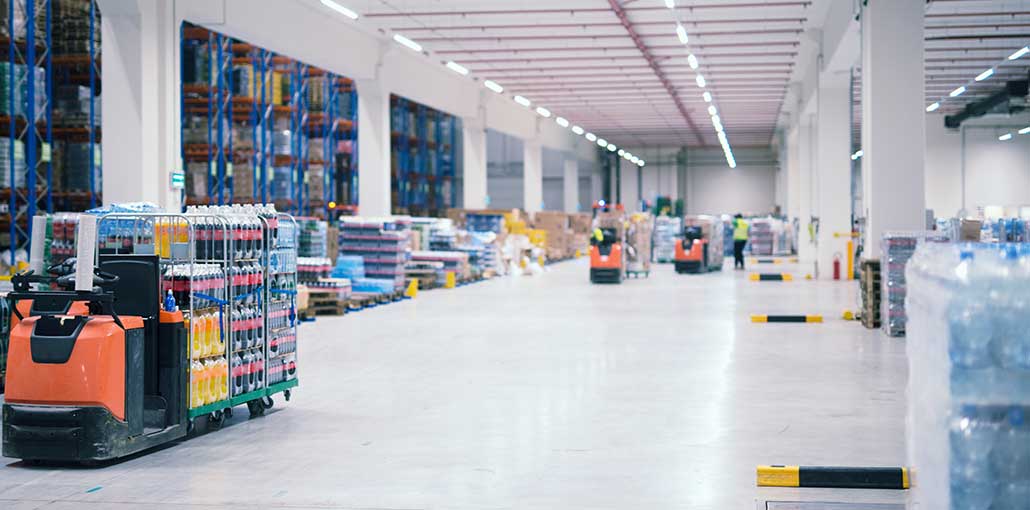When warehouse operations are evaluated, the most common question we get is “When is a warehouse full?” and What is a warehouse capacity? Efficiency drops when there’s between 80% to 85% space utilization. This can be both from a storage and movement perspective. Pallet movement can become restricted, and it may take several actions to move or replenish pallets.
Temporary floor positions can also restrict aisle movement. Multiple moves can increase costs and slow down the processing. Many businesses will need to increase warehouse space utilization and find new facilities sooner than they expected.
It is important to determine if you can reduce the amount of space that you use by looking at the age of your inventory and liquidating excess stock. This should be your first step in your DC space analysis. Are you able to show inventory reports displayed by SKU inventory supply and inventory turnover over time? This will tell you how long it will take to get rid of the inventory. These reports are crucial when discussing space usage with management.
Also read: What is SAP Business Warehouse?
Here are 15 ways to increase your warehouse space utilization beyond the initial step of dealing with potential overstock.
1. The Start Point
Your storage capacity and utilization should be quantified. Analyze the current layout in terms of capacity and utilization. This includes rack configuration, slotting/pick philosophy and receiving, replenishment, inventory management, packing, and shipping. You should also consider seasonal peak trends, as well as a volume analysis of outbound and inbound product flows.
2. Make the most of your vertical space
Take a lookup to ensure you are using every inch of vertical space. To maximize your span height, you might consider storage media. What percentage of your vertical space is being used? Consider how your design could impact your fire code and sprinkler design.
3. Analyze Your Department Space
Find functions that don’t require high ceilings. Many large departments such as packing and shipping have unused overhead space.
4. Consolidate locations
Multiple locations are possible to store the same item. Combine them to maximize warehouse space utilization. This can be done either during the putaway or as an independent function.
5. Right-Size your Slots
To maximize the use of your picking slot cube, match the sales and size of the item with the appropriate size pick slot. This can be made easier by having different sizes of picking slots. This same principle applies to areas where you store excess stock or reserve. To reduce replenishment, forward picking should allow for 4-7 days sales per SKU.
6. Overstock can be taken off-site
You might consider offsite storage if you have excess inventory that is only needed for a small number of items. This will allow you to free up space for fulfillment.
7. Drop Shipping as an Option
Dropshipping is a great option if you need to store large quantities and reduce costs.
8. Aisle Widths
What width are your warehouse aisles at the top? You should design your warehouse aisles to be as wide as possible to match the material handling equipment without compromising operational efficiency.
9. Cross Docking
Cross-docking large orders of back orders or single-line order releases can be an option to reduce inventory storage space.
10. Best Use of Your Building
You should carefully examine your building in order to find the best way to use it from a space perspective. Clear stacking height, column spacing, and building impediments are all important. Match vertical space requirements with building characteristics.
Also read: 8 Advantages of Effective Supply Chain Management
11. Storage Depth
You should not only evaluate the effectiveness of height-to-depth storage but also how they are used. For example, double-depth racks might be a good idea.
12. Stockpile Supply
You should manage your inventory if you store packing materials or supplies. You can check with your supplier of corrugated materials to see if they have enough inventory on-site. Then, take delivery every few working days.
13. Door Use
You have a separate shipping and receiving Docks, Consider combining them to save space.
14. Mezzanine Installation
Consider using a mezzanine if your building layout allows. This will allow you to use functions that don’t require high-bay storage. Although they are expensive and can be permanent, these will maximize warehouse space utilization.
15. Keep it simple
If you are faced with a decision between a simple or complex solution, go for the simple one. One example is adding pallet rack tiers up. This could increase the complexity of the task. Is your investment paying off?
Warehouse space can often be 15% to 20% of the order cost. It is costly and time-consuming to move into a new space. You should designate someone to manage your warehouse space analysis and planning.










Leave a comment